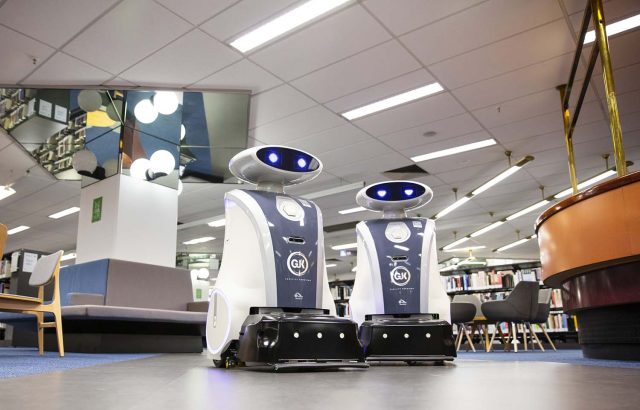A Key Technology Trend Revolutionising the Built Environment Space

What is the impact of SMART buildings on client and employee experiences, cost efficiencies, and the implementation of IoT from an FM perspective?
In an era where technology permeates every aspect of our lives, the evolution of SMART buildings has emerged as a groundbreaking trend in the realm of architecture and facility management. These intelligent structures leverage interconnected technologies to create responsive, sustainable, and productive environments. In this blog, we will delve into the evolution of SMART buildings and explore their impact on client and employee experiences, cost efficiencies, and the implementation of the Internet of Things (IoT).
Interconnected Tech: Making Facilities More Responsive, Sustainable, and Productive
At the core of SMART buildings lies the integration of interconnected technologies. Through a network of sensors, devices, and systems, these buildings collect and analyse vast amounts of data, enabling them to respond dynamically to changing conditions. For instance, automated lighting systems adjust brightness based on natural light levels, reducing energy consumption and improving sustainability. HVAC systems adapt in real-time to optimize comfort while minimising energy waste. Such responsiveness not only enhances occupant experiences but also significantly reduces resource consumption and greenhouse gas emissions, making SMART buildings environmentally friendly.
Additionally, interconnected tech improves productivity within SMART buildings. Integrated communication systems facilitate seamless collaboration and connectivity among employees, regardless of their physical location. Smart meeting rooms equipped with advanced audiovisual capabilities enable more effective presentations and discussions. Moreover, facilities management teams can remotely monitor and control various building functions, optimising maintenance schedules and minimizing disruptions. By leveraging interconnected tech, SMART buildings create environments that boost productivity and operational efficiency.
Focus on Client and Employee Experience
In the evolution of SMART buildings, there is an increased focus on providing exceptional experiences for both clients and employees. Recognising that buildings shape the perception of an organization, SMART buildings aim to create attractive, modern working environments that promote wellness, engagement, and productivity. Incorporating elements such as flexible workspaces, ergonomic designs, and biophilic features, these buildings prioritise employee well-being and satisfaction, leading to increased productivity and reduced employee turnover.
Client experiences are also elevated through SMART building features. For example, visitor management systems streamline check-in processes, providing a seamless and secure experience. Interactive digital signage and wayfinding systems improve navigation within large buildings, ensuring clients can easily locate their desired destinations. By prioritising client and employee experiences, SMART buildings enhance overall satisfaction and engagement, positively impacting business outcomes.
Driving Cost Efficiencies through Energy Consumption and Data-Driven Decision Making
Another significant advantage of SMART buildings is their ability to drive cost efficiencies. By optimising energy consumption, these buildings reduce utility costs and minimise their environmental footprint. Smart meters and energy management systems monitor and control energy usage, identifying areas for improvement and enabling proactive energy management strategies. Data-driven decision making plays a crucial role in identifying inefficiencies, allowing facility managers to implement targeted solutions and achieve greater operational efficiency.
Moreover, the implementation of IoT in SMART buildings enables data-driven insights and empowers building operators. Through the integration of sensors and data analytics, IoT systems generate real-time data on building performance, occupancy patterns, and environmental conditions. This wealth of information helps in making informed decisions regarding maintenance, space utilization, and resource allocation. According to CBRE1, 75% of building occupiers cite better quality data and accuracy as key to achieving their real estate goals. SMART buildings leverage IoT to provide valuable insights, resulting in improved efficiency and cost savings.
Huge Advancement in Sophistication and Use of IoT
The evolution of SMART buildings is witnessing remarkable advances in the sophistication and use of IoT. According to Navigant Research2, the IoT market for intelligent buildings is projected to rise to $22 billion in 2026. This growth is fuelled by advancements in sensor technology, connectivity, and data analytics. IoT enables real-time monitoring and control of building systems, predictive maintenance, and automation, leading to increased efficiency, reduced downtime, and enhanced occupant comfort. As technology continues to advance, SMART buildings will become even smarter, more interconnected, and capable of delivering unprecedented levels of performance.
At GJK, we recognised this early and focused on integrating our services as part of an overall connected facility ecosystem, in order to optimise support to our clients and become efficient and more productive. GJK’s revolutionary SMART Technology and sensors now capture and report on a range of anomalies such as bad odour, empty dispensers and overfull bins, allowing us to quickly rectify any issues as soon as they arise. We also track occupancy levels to determine usage of buildings we service. This understanding means that cleaning regimes and all manner of facility services can be adjusted for maximum efficiency based on our clients’ needs, allowing us to deliver a true tailored and performance-based solution for the site.
Overall, the evolution of SMART buildings represents a key technology trend that is transforming the built environment as a whole. Through the integration of interconnected technologies, these buildings enhance responsiveness, sustainability, and productivity. The focus on client and employee experiences ensures that SMART buildings provide attractive, modern working environments that promote wellness, engagement, and productivity. By driving cost efficiencies through energy consumption optimisation and data-driven decision making, SMART buildings achieve greater operational efficiency. As the implementation of IoT continues to advance, the future of SMART buildings promises even greater sophistication, empowering building operators with valuable insights and transforming the way we live and work.
References



